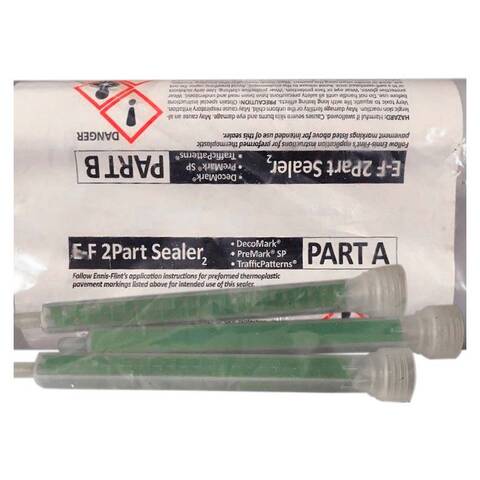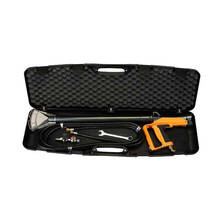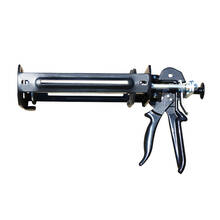You are here
PreMark 2-Part Sealer Kit For Preformed Thermoplastic
- Basic kit to get you started on Preformed Thermoplastic
- Required when installing on concrete or when using multi-colored preformed thermoplastic
- Can be used on asphalt when necessary
Shipping Note
This product has flammable solvents which classifies it as hazmat and will only ship LTL freight. Prices reflect the shipment of a single box on a pallet going LTL.
If you only need 1 kit, there isn't much we can do to save you money unfortunately.
Buy 2 or more and get a major discount! (add 2 or more to your cart and then view your cart to see the discount)
Another option might be the PreMark 5-gallon 1-part sealer
Since this product is very expensive to ship, the best way to save money on this is buying in bulk. If you order the 2-Part Sealer and PreMark XF thermoplastic together, it can all ship on the same pallet. Call us to put a quote together and save some money. +1(800) 689-2098
Description
In order to use preformed thermoplastic stencils on concrete or with multi-color markings, it is required to use a PreMark® Sealer.
The Ennis-Flint PreMark 2-Part Sealer kit ships with almost everything you need to get started with putting down thermoplastic on concrete or using multi-colored markings such as interstate or bike lane marks with green backgrounds. The only thing the kit doesn't include, is the sealer gun which we do sell separately.
Included in the kit:
- 2 (each) pre-filled sealer epoxy cartridges (total of 4 cartridges)
- Mixing nozzles
- 3 rollers
- Roller applicator
- Latex gloves
If you aren't familiar with the PreMark sealer, the short version is that you clean the pavement you'll apply the stencil or marking to, then heat it to remove any moisture. Next, you mix the epoxy using the sealer gun and go over the area with the sealer in a back and forth snake like motion. Using the supplied roller, smooth the sealer out so it's uniform over the area to be marked. Install the marking and heat as normal. Just make sure you read the instructions for the full installation instructions.
The PreMark 2-Part Sealer can also be used on asphalt when necessary but isn't required unless otherwise directed and the two included cartridges will cover between 80 - 100 sq ft
Purpose
If you're new to preformed thermomarking, PreMark preformed products require a special 2-part sealer if you're using multi-color markings or if you plan on applying preformed thermoplastic to concrete. If you've worked with the PreMark products in the past, you might be familiar with the older (but still available) 1-part sealer.
The 2-part sealer is actually a cleaner, easier install than the older 1-part method that seasoned folks might be used to and unlike the previous sealer, you don’t have to wait for it to dry before providing heat. The 2-part sealer also creates a vapor barrier between the sub-surface and the marking ensuring that the marking is not affected by the subsurface. Whereas the older 1-part sealer just sinks into the subsurface and helps the marking grab on. You also have to wait for the 1-part sealer to dry completely before applying heat to the marking and the 1-part is designed primarily for concrete only where the 2-part is designed for both concrete and to be used on interconnected large markings highway shields, logos, or anything expensive because at the end of the day, it’s a better product.
Main Differences
1-part sinks into the sub-surface and helps create a solid bond. Overtime, the sealer can break down and allow the marking to loose its bond.
2-part does the same but, creates a barrier so water, salts and other factors can’t pop the marking.
Pavement Surface Information
There's really only two surfaces you can apply preformed thermoplastic to, Asphalt or Concrete.
Asphalt
If you're applying thermoplastic to asphalt, you don't really need a sealer because the thermoplastic will stick to the oils within the asphalt, creating an excellent bond. There's a catch however... If you're applying thermoplastic to old, oxidized asphalt, the oils are gone from the surface and there won't be anything permanent for the marking to bond with. In this case, you MUST use a sealer before applying the marking for maximum performance. If you're planning on adding multi-colored markings to asphalt, we also highly recommend using the sealer, regardless of the asphalt condition.
Concrete
Regardless of the age or condition of the concrete, you MUST use a sealer prior to installing a preformed thermoplastic marking. Concrete has a unique property where moisture and contaminants can rise to the surface of the concrete and interfere with the bond between the marking and the concrete. Because of this, the lifespan of the marking can become greatly reduced and in some cases without going into a bunch of chemistry, can eat away at the marking. It's for this reason, it is required that you use a sealer with concrete.
In The Box
Kit contents:
1 x Instruction Sheet
5 x Pair Disposable Blue Rubber Gloves
1 x Large Tip Black Marker
1 x Trash Bag
2 x Part A & B Sealer Cartridges
4 x Mixing Tips
4 x 12" Foam Rollers
1 x Disposable Roller Applicator
1 x Aluminum Rolling Pan
You Might Like
Instructions Overview
IMPORTANT NOTE BEFORE YOU START APPLICATION: Ambient and surface temperatures must be 45°F (7°C) and rising for EF 2-Part Sealer use. For large area markings, such as colorized bike lanes or large interstate shields with multiple material sections, do not apply two-part sealer to an area larger than can be heated in 20 minutes. Leave the 8 inches of material closest to the continuation edge unheated. Repeat steps 1 through 5 working in intervals until entire application area is complete
1. PREPARE application area thoroughly. All loose particles, sand, dust, etc. must be removed by using a power blower, compressed air, or sweeping completely. Do not apply over paint, with the exception of over a thin, temporary layer of cured and well-bonded paint on new asphalt. Do not apply over tape, MMA, epoxy, salt, deicing agents, chemicals, or very oily substances. Always handle the material with care. A multicolor marking consists of interconnected individual pieces of preformed thermoplastic. Do not lift an entire assembled segment by holding onto a small individual piece, as it may separate. The material should be handled on the plastic sheet with which it is packed until it is placed in its final position. With marking positioned on the surface, delineate area or trace completely around the marking with chalk or crayon to create an outline. Move the unheated marking from the pavement carefully and set aside for application of EF 2-Part Sealer (“the sealer”).
2. APPLY the sealer after ensuring that no moisture is present. Surface moisture is not often visible; always assume moisture is present. Remove moisture by drying the application area with a propane fueled heat torch. It is not necessary to heat the substrate to a specific temperature.Remove the sealer kit contents from the carton. Install the sealer cartridges into the sealer gun. Point the gun upwards (nose up), and remove the cap or nut and plugs. With gun still pointing upwards, attach the mixing nozzle and ensure it is properly secured to the sealer cartridge. Point the gun downward and squeeze the handle gently until the sealer is approximately 2 inches from the tip of the mixing nozzle. If circumstances do not permit the mixed sealer to be used within 10 minutes, remove the mixing nozzle, reinsert plugs and secure with cap or nut. One 300/600 ml sealer cartridge is sufficient for applying 50 sq. ft. of PreMark material. It is critical the sealer does not cure before PreMark has been applied and heated; therefore, do not apply two-part sealer to an area larger than can be heated in 20 minutes. Do not apply sealer outside the chalk line, as it may stain the substrate. Holding the tip of the nozzle over the application area, squeeze out an appropriate amount of sealer. Spread the sealer within the delineated application area with the roller provided. The sealer should appear as a light coating with a shiny surface. Do not wait for the sealer to cure before applying the PreMark material. Cold temperature consideration: the sealer may dispense more slowly in temperatures around 45ºF (7ºC). Whenever possible, keep the unopened sealer catridges insulated with a material heater blanket or inside the cab of the work vehicle keeping sealer closer to room temperature until ready for use.
3. POSITION the PreMark material. After the sealer application, immediately position the PreMark segments onto the pavement surface, top side up. The top side of PreMark has heating indicators (indents), and the factory-applied surface treatment (beads, anti-skid elements or a combination). There should be no gaps between the adjoining segments, and the segments should align properly to form overall marking according to diagram provided in the package. Ensure proper layout is obtained before heating the material. Heating should begin immediately after proper layout has been confirmed.
4. HEAT the PreMark material. Standing with the wind at your back, face the marking so the wind will move heat from the torch over the unheated material, away from your feet. Heat material slowly but steadily until molten, keeping the torch nozzle about 4 to 8 inches above the material, while using a sweeping motion approximately 2 to 3 feet wide. Heating with the torch nozzle closer than 4 inches will cause superficial scorching of the material without adequate melting throughout. Regularly-spaced heating indicators (indents) have been manufactured into the top surface of the material. The closing of these indents will provide a visual cue during application that the material has reached a molten state indicating proper bond and bead embedment. Continue heating the material until the heating indicators (indents) close, the material edges round or “roll”, and the material seams fuse together. Note: Insufficient heat will result in inadequate bonding and failure. Significantly overheating the material will over-embed the factory-applied surface treatment into the PreMark material, causing the marking to be less retroreflective and/or skid-resistant initially.
5. INSPECT for proper bond and bead/anti-skid element embedment after the material has cooled to near ambient temperature. Make sure edges are rounded and thoroughly bonded. Perform a chisel test to verify bond. Look carefully at the heated material away from the edges for any remaining visible indents and/or under-embedded glass beads/anti-skid elements. Using a 1”chisel, hammer a small “V” shape (<) into the material. Using the chisel tip, carefully lift up the point of the “V” shape (<) off the pavement surface. Evidence of asphalt aggregate bonded to the underside of the lifted material indicates good adhesion. Little to no evidence of asphalt on the underside of the lifted material indicates the marking was not heated sufficiently in that area. Apply a small amount of sealer beneath the material, press it back into place, and reapply heat until adequate bonding has occurred. Note: Do not leave the project or begin applying adjacent rows until a sufficient bond has been established, as attempts to reheat at a later date will be unsuccessful.
Cold temperature consideration: Ambient and surface temperatures must be 45°F (7°C) and rising for EF 2-Part Sealer use. Material will not fully bond with the pavement until the sealer cures. Since the sealer will take longer to cure in cooler temperatures, 45°F-55°F (7°C-13°C), allow for more time to elapse before checking bond. To facilitate sealer curing, apply more heat to the material surface, but carefully avoiding risk of sinking all the surface treatment. Thereafter, check the bond at 15 minute intervals. Sealer should cure within an hour at the 45°F-55°F (7°C-13°C) temperature range. Note: When applying a very large marking, such as an interstate shield or bike lane with multiple material sections, leave the 8 inches closest to the continuation edge unheated. Repeat steps 1 through 5 within 50 sq. ft. sections at a time until entire application area is complete. Do not expose uncovered areas of applied sealer to the flame of the torch, as this will cause the sealer to cure prematurely
Replacement Parts & Accessories
The following are a list of replacement or add-on parts for this product.






